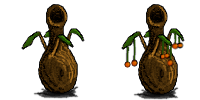Anatomy
The vase-tree is dominated by its trunk, which resembles a large vase (from which it gets its name). The vase is hollow, and is ringed with rows of downward-pointing internal spines (which help it trap and digest any animals that fall in). The vase typically forms around a single large knot in the wood of the trunk (known as the "navel" of the tree), which is often drilled out by those knowledgeable in desert survival as the fastest way to the tree's water supply. The upper end of the trunk centers around a large opening that supplies water and nutrients to the tree.
Vase trees only have a few large leaves that sprout from large stalks coming out of the trunk. The underside of these leaves is covered (in most species) with a thick growth of vines. The ends of these vines sprout flowers that then give way to small fruits. When these fruits are ripe, the vines detach from the leaves. Many of these fruits are edible to humans, and the various nomads and wildlife of the planet often consume them.
Most vase-trees are between 5 and 10 meters high, although specimens as large as 250 meters are known to have existed when humans first arrived on New Albuquerque. Most of the largest vase-trees were harvested for wood in the early years after the crash of Garcia's Hope.
Economic value
The wood of the vase-tree is porous, and not suitable for most construction applications, although larger trees have more solid wood, which is. The wood of even small vase-trees is still valuable for paper-making or fuel. The fruits (in most species) are edible. The fruits are typically semi-sour in flavor, yet nourishing, and have become the basis of several dishes in the cuisine of New Albuquerque. The main economic value of the vase-tree lies in its ability to store water in the desert wastes.
Another use of the vase-tree is the downward-pointing spines that grow in the interior of the trunk. These are often harvested and used as spears by Vorgon nomads.
The Tale of the Vase-tree
The tale of the vase-tree was a common creation myth among the Vorgon tribes of New Albuquerque. The Vorgons are also known as "goblinoids", though this name is considered to be somewhat derogatory, because of their resemblance to goblins from human folklore.
The gist of the tale is that when the gods created the world, they inhabited it solely with plants, the greatest of which was the vase-tree. Little did the gods realize that the vase-trees would bring forth the Vorgon race (who are claimed to be the parents of all the other animals through a series of degenerate events). The first Vorgons are said to have climbed out of the trunks of the vase-trees, bending inward the long spikes that vase-trees grow on their interiors, which had previously pointed upward. This so upset the gods that they sent a great calamity to dry up most of the world's water to punish the vase-trees.






